The first round of the second leg of the Women’s Grand Prix in Kazakhstan was filled with twists and turns, where three players – Bibisara Assaubayeva, Stavroula Tsolakidou, and Tan Zhongyi secured wins.
As the clock neared 15:00, players entered the elegant hall on the 11th floor of the Rixos Khadisha Hotel, with its chandeliered grandeur and golden accents that perfectly captured the prestige of the occasion. Tension filled the air as players settled into their seats, ready for the battles ahead. The ceremonial first move was made by Gabit Abdimazhitovich Syzdykbekov, Mayor of Shymkent, on board one between Nurgyul Salimova and Bibisara Assaubayeva—marking the board where the first victory of the day would later unfold.
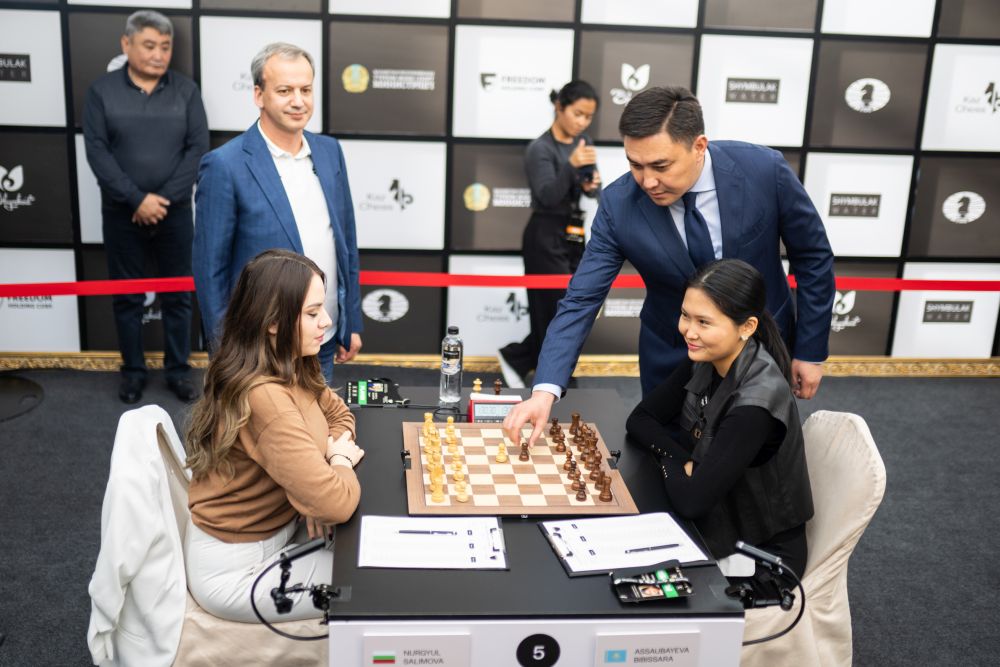
The opening round’s decisive outcomes included Stavroula Tsolakidou’s win against Batkhuyag Munguntuul and Tan Zhongyi’s hard-fought victory over Elisabeth Paehtz, the last game to conclude after intense 5.5 hours of play. For fair play, players from the same country were paired together in the first round which was the case between Kateryna Lagno vs. Aleksandra Goryachkina, Divya Deshmukh vs. Humpy Koneru, where both games ended in draws.
With the majority of games ending decisively, and even the drawn games being far from boring, the day was filled with exciting chess. Let’s take a closer look:
Nurgyul Salimova vs. Bibisara Assaubayeva 0-1
Playing with the black pieces, homegrown hero Bibisara opted for an aggressive approach to White’s early kingside castle by storming the h-pawn down the h-file. Bibisara’s opening approach was a good one – she took Nurgyul out of her usual Catalan comfort zone and into unfamiliar territory. Although Black did not have a concrete advantage, she was clearly steering the ship. Eventually Nurgyul slipped by untimely returning a pawn and found herself in an inferior position. The critical moment of the game came on move 21.

Here Salimova could have protected both her dark-squared bishop and the b2-pawn by 21. Qc1 with an unpleasant but still holdable position. Instead, she played 21. Bf2? but Bibisara snatched a pawn with 21…Nxb2.
White could have put up a stubborn resistance but after several inaccuracies by Nurgyul, Bibisara traded off most of the pieces and liquidated into a winning endgame. After the additional 30 minutes was added by move 41, Salimova, who had been playing with a minute or less for 10 moves, finally had time to properly assess the position, and after some thought resigned.

This victory was important for Bibisara, as not only does it give her a strong start, but she was able to secure the point with the black pieces. After her game, she exclaimed in an interview that this was her first win with black in her last 3–4 tournaments! Playing in her home country of Kazakhstan, she has both additional pressure and support, and with such a dominant start, she is definitely one of the tournament favorites.
Kateryna Lagno vs. Aleksandra Goryachkina 1/2-1/2
The rollercoaster game between Lagno and Goryachkina started off as a regular Giuco Piano, an opening that commentator Miro noted as having too many familiar positions that all seem the same. Goryachkina opted for the less popular 6…a5 and later started aggressive kingside play that would never materialize into any kind of advantage.
In fact, the opposite occurred – Lagno secured her kingside and started pushing on the queenside. By move 30, she achieved a winning position.
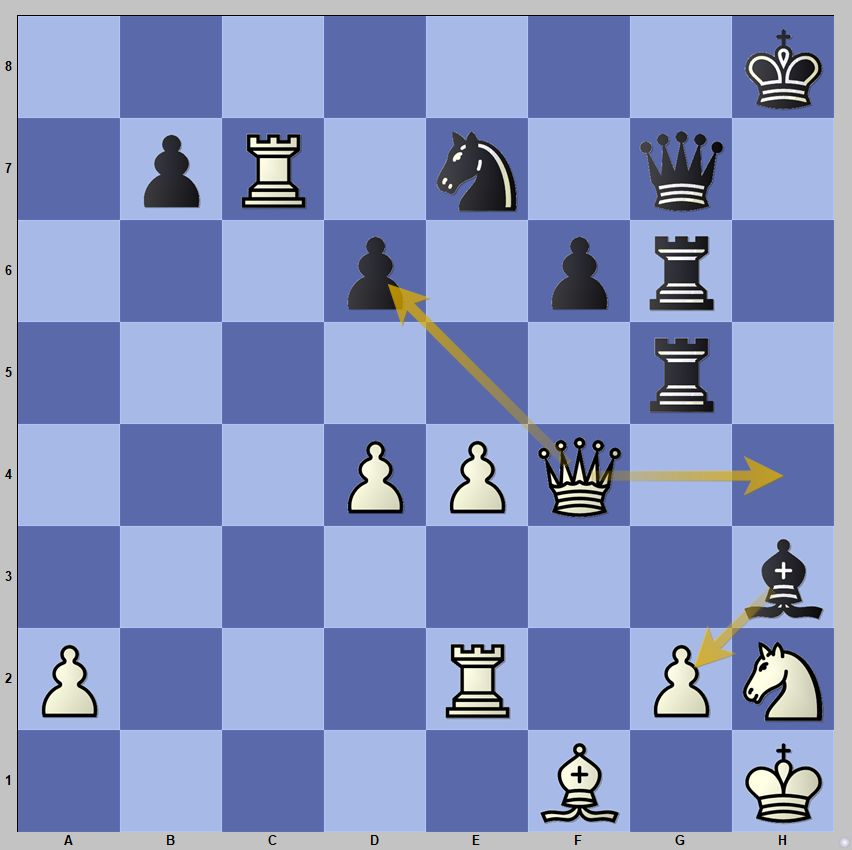
Although it looks scary, White’s king is safe and the computer evaluates this as a +9 advantage for White after 31.Qxd6. Indeed, Black can’t create any real threats after capturing on g2. For example 31. Qxd6 Bxg2+ 32. Bxg2 Rxg2 33. Rxg2 Rxg2 34. Qd8+! Kh7 35. Nf3! However, Kateryna erred, possibly overestimating Black’s attack and instead opted for 31.Qh4+. After 31…Rh6 32.Rxe7 Rxh4 33.Rxg7 Bxg2+ 34.Bxg2 the position became completely equal.

But the twists did not end there – a few moves later, White seized an advantage once again in the form of a dangerous d-passer, but under time pressure, and a couple of moves before reaching time control Lagno blundered, and the game shortly ended in a draw.
Batkhuyag Munguntuul vs. Stavroula Tsolakidou 0-1
In what was another lengthy game, Stavroula playing with the black pieces, reached a comfortable position out of the opening and emerged slightly better in an opposite-colored bishop endgame with rooks. Tsolakidou was probing Munguntuul’s defenses for a while and eventually got her chance.
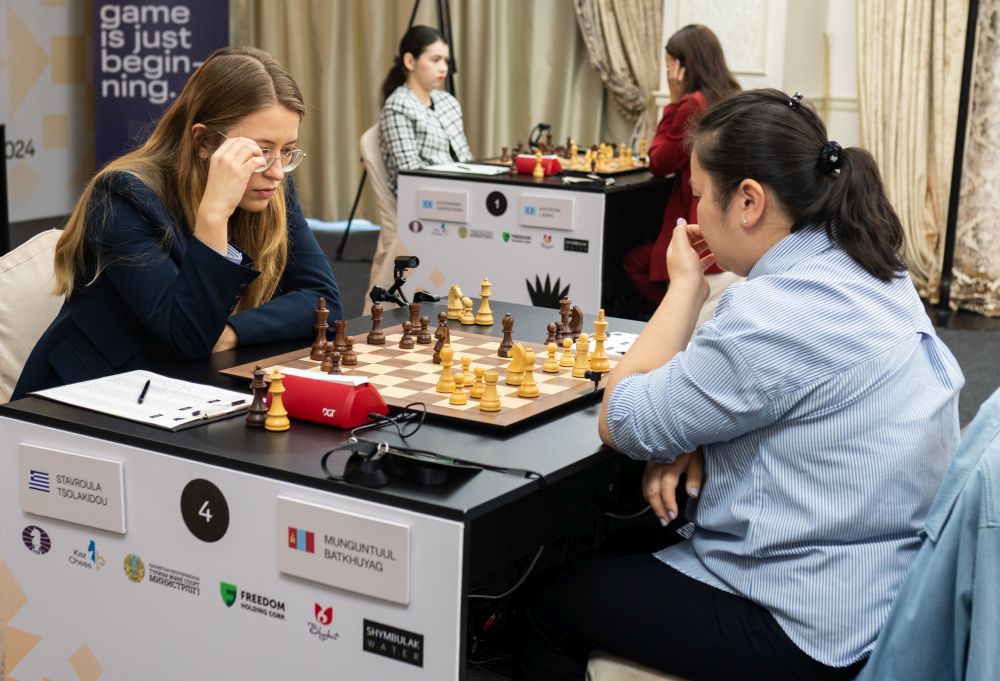
First, White retreated her bishop from active position and then made the major mistake by moving the king into the wrong direction:

50.Ke1? (50. Bh5 with the idea of 50…Rh7 51.g4 was the only chance) allowed Black to infiltrate the kingside with 50…Rh7 followed by Rh1-Rg1, eventually picking up the g-pawn. White tried to create some queenside counterplay, but to no avail. Eventually, Black’s g-pawn ran down the board to glory, securing an early win for Stavroula.
Divya Deshmukh vs. Humpy Koneru 1/2-1/2
The game between Divya and Humpy was an exiciting clash of generations – Divya, a recent double gold Olympiad medalist for Indian, and Humpy, a titan in Indian chess. Both players played accurately, and after 41 moves the game ended in a quiet draw.
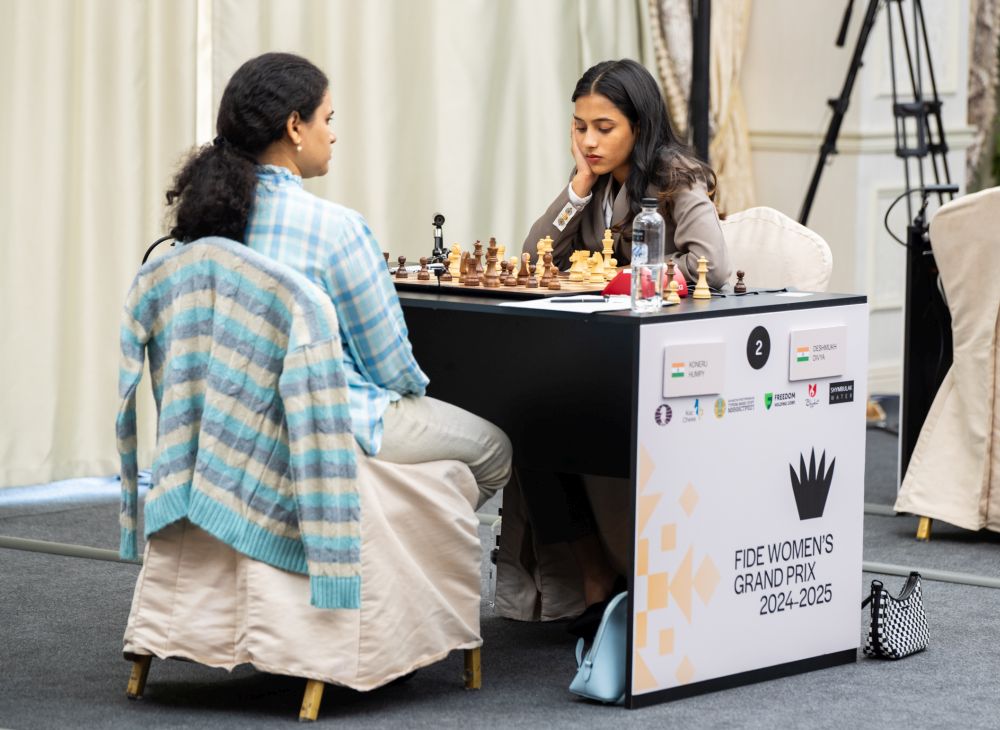
Tan Zhongyi vs. Elisabeth Paehtz 1-0
The last game to end was between Tan Zhongyi and Elisabeth Paehtz, spanning 107 moves over more than 5 hours. Despite a relatively early exchange of queens, the position was balanced but full of life. However, on move 33 instead of 33…Rc3 Paehtz made the bold decision to play 33…Nxg4 hoping for 34.hxg4 Bxg4.
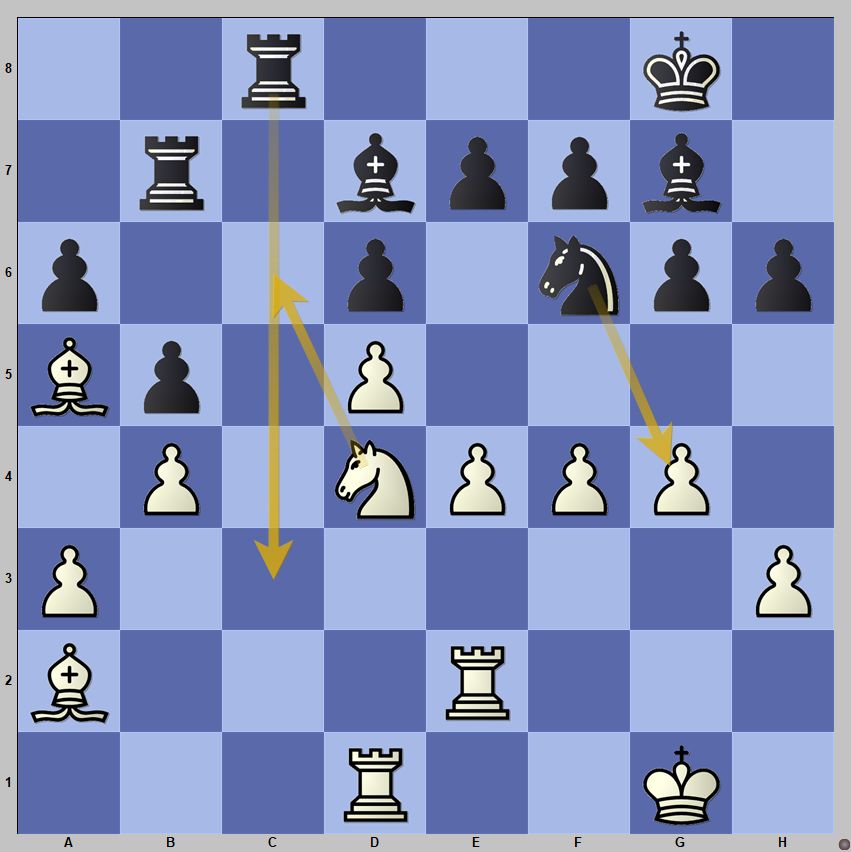
However, Tan first inserted the zwischenzug 34.Nc6 threatening Nxe7, securing an outpost, and completely restricting the mobility of the black Rooks. White continued to hold a minor advantage for most of the game, but eventually equality was reached with White having three active minor pieces – two bishops and a knight, versus Black’s two rooks.
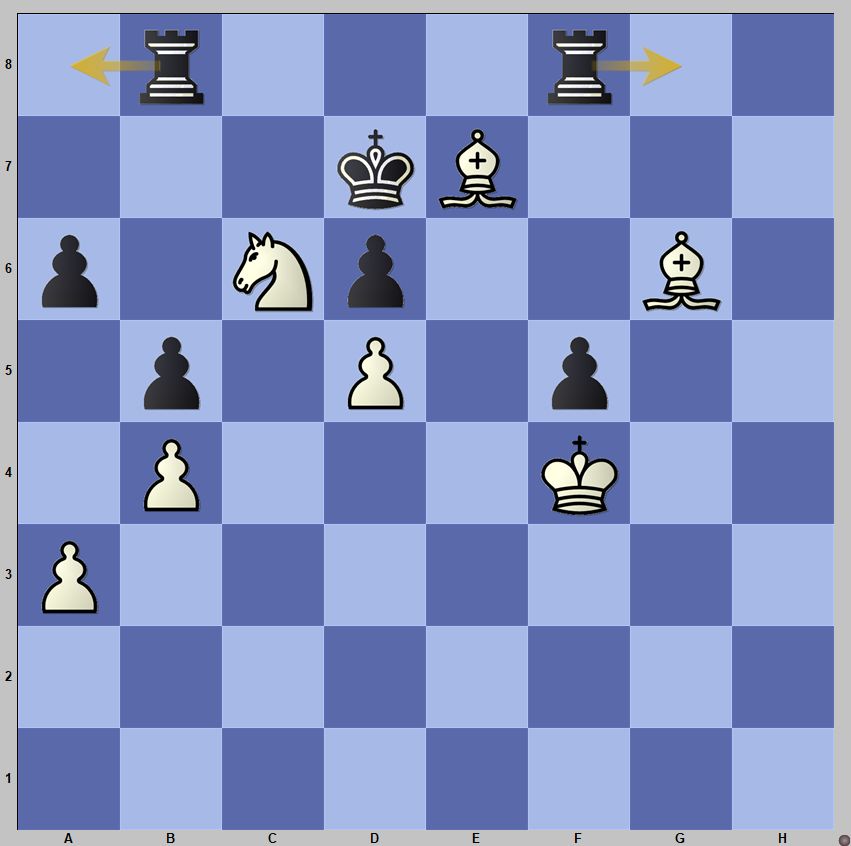
The final mistake came on move 67 where Black played 67…Ra8? (instead of 67…Rg8!), saving the wrong Rook and allowing White to keep the dominating knight. After 68.Bxf8 Rxf8 69.Bxf5, Black’s position quickly fell apart. Tan showcased her endgame technique in the Knight and Bishop vs two pawns endgame, eventually leading to a Bishop and Knight checkmate. This is not the most common checkmate to occur in chess, but it is one that should be drilled, and seeing it come up in elite levels is a good reminder for those at home to practice it!
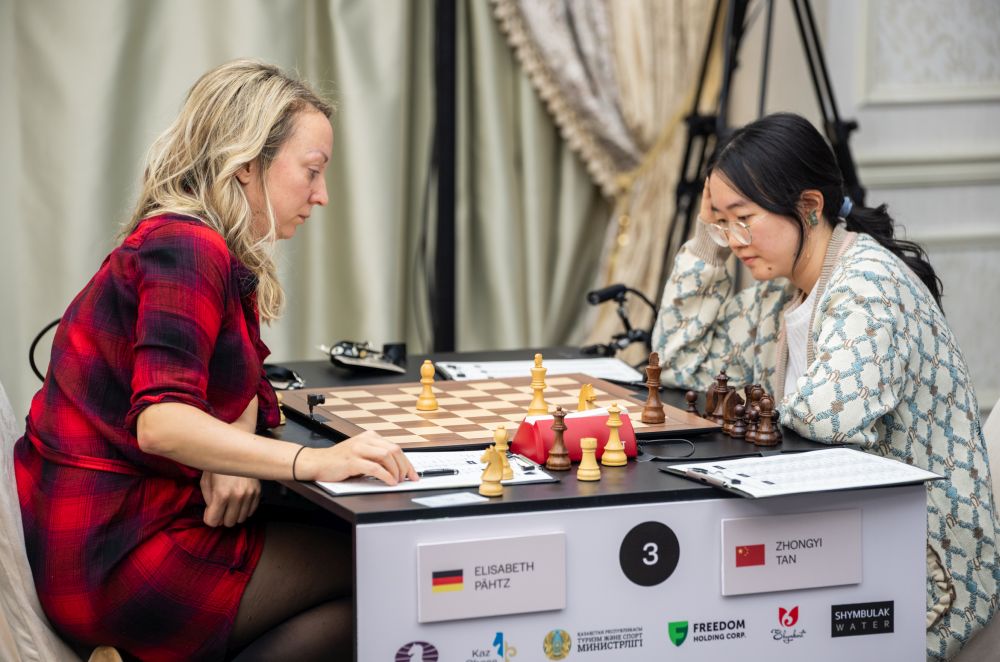
Tan has had a successful year, having won the FIDE Women’s Candidates, and with such a strong start she has further positioned herself as one of the favourites in the tournament. Interestingly, both Tsolakidou and Assaubayeva, who join Tan in the lead after Round 1, also had a strong start in the tournament series’ first leg in Tbilisi, where they began with wins. Could history be repeating itself? We’ll see in the rounds to come!
Round two pairings and dates
The second round of the second leg in the 2024/25 Women’s Grand Prix series starts on Thursday, 15:00 local time in Shymkent, Kazakhstan.
Round 2 pairings:
Goryachkina, Aleksandra – Assaubayeva, Bibisara
Tsolakidou, Stavroula – Salimova, Nurgyul
Paehtz, Elisabeth – Munguntuul, Batkhuyag
Koneru, Humpy – Tan, Zhongyi
Lagno, Kateryna – Divya, Deshmukh
More information about the event, including the regulations and details of the pairings, as well as live games can be found on the official website: womengrandprix.fide.com.
Written by Charlize van Zyl
Photos: Konstantin Chalabov and Viktoriya Abramova

